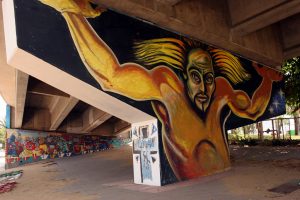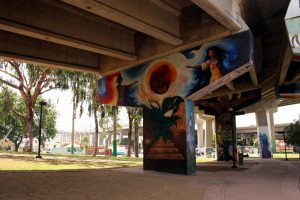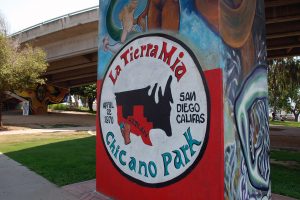Madeline Keyes- Chicano Park’s Impact
Madeline Keyes
Chicano Park’s Impact
The portfolio will highlight the benefits of transforming an urban area, such as Chicano Park, into a beautiful art display and community park, and what the murals mean to the community that created them. Chicano park, created by an artist named Salvador Torres in 1969, is a great representation of art transforming an urban area and bringing a community together.
One theme that my portfolio will be focusing on is how Chicano Park brought a community together to transform a space using art and create a beautiful outdoor public space for all to enjoy. I will also be focusing on how the art depicts the hardships, history, and mythology of the Chicano people and how these murals are important to them.
The park was created when artist Salvador Torres returned home from art schooling to see his home and community destroyed by the construction of a highway. His first reaction was anger- as the community had not been asked for the land, it was taken from them. Then he looked at it from another perspective and began sketching ideas to turn the concrete pylons into canvases for Chicano murals. In 1969, Torres created the Chicano Park Monumental Public Mural Program, where he brought the community together to gain the respect of state officials and the support of the community to pull this project off. He wanted to keep open lines of communication between state officials and the artists who were planning on painting the murals, so that they could work together as equals. After much communication with state officials and the city, the long-awaited murals were approved, and the community could begin transforming this space. The murals were painted by hundreds of members of the community, who were determined to turn this concrete pylon jungle into a beautiful art display park for the community to enjoy.



The murals depicted in the images above represent important ideas, as the first image depicts Atlas, from classic mythology, supporting the bridge on his hands and back. This image represents the strength the community had to confront the state about the land and to fight to get it back. The second image depicts the birth of La Raza, as a man and woman show their creation they made together, and the green leaves seen at the bottom is representative of their roots in Mexico. Finally, the last image depicts the Chicano Park logo, and as stated on the Chicano Park website, “A hand reaches up to place a blue dot on San Diego, illustrating the location of Chicano Park with the greater homeland of Aztlan, which is painted red within the map of the United States.” This is a great representation of how though out the murals all were, and that the people of the community made sure they were representing something special and meaningful to them.
This park has huge importance to understanding the community that it was created in, as all the pylons have their own representation of the people’s struggles. The murals specifically are each depicting an aspect of Chicano culture, from the art form to the Mexican roots, to the hardships of taking the land back from the city. Torres played a very critical role in creating the park and murals, and it was critical for that to be him since he was directly affected by the construction of the highway which destroyed his home and community that he knew. He represented a lot of the Chicano community by fighting this battle, and that was an important aspect of getting the approval for the park and murals. The park itself represents this battle, fought by Torres and other artists from the community, and has become a great spot to observe the history and mythology of the Chicano community. The community created this space for itself, but yet again, it is so much more than just a park.
Bibliography:
All information used was found from:
History of Chicano Park, Barrio Logan, San Diego, CA, www.chicanoparksandiego.com/.

